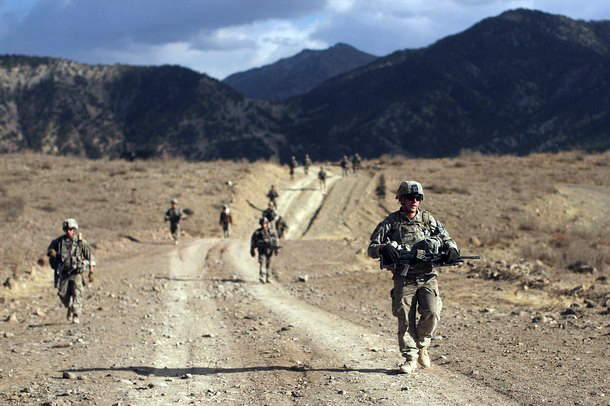
Since the American offensive in Iraq in 2007 designed to suppress the Sunni-led insurgency in central Iraq, the term "surge" has entered the lexicon of American military activities, achieving an almost iconic position as the answer to multiple politico-military problems. Most recently, it has been used to describe–and justify–the American Marine incursion into Helmand province in Afghanistan, one of the major stronghold areas of the Taliban and the heart of opium country in that country. The operation to capture the city of Marjah has been the centerpiece of this activity.
What exactly is a "surge?" It is a relatively new term that is not found in American military doctrinal statements. Indeed, a quick perusal of the United States’ primary document on cointerinsurgency or COIN (The U.S. Army/Marine Corps Counterinsurgency Manual: U.S. Army Field Manual 3-24, Marine Corps Warfighting Publication No. 3-33.5) does not reveal a single reference to the term. Instead, the actions that collectively comprise surging are found under the much more descriptive (if arguably less catchy) description "clear, hold, build" (see Sections 5-51 and 5-80 of the Manual).
According to FM 3-24/Warfighting Document 3-33.5, a clear-hold-build operation "is executed on a specific, high-priority area experiencing over insurgent operations," by which both the Iraqi action and the Marjah initiative qualify. The operations has a three-fold and sequential set of purposes: to "create a secure physical and psychological environment"; to "establish firm government control of the populace and area"; and to "gain the populace’s support." The first of these goals (clear) is accomplished by the "destruction or expulsion of insurgent" forces. The second (hold) is attained by the "deployment of security forces." The third (build) is gained by "improving living conditions and restoring normalcy."
The success of this kind of operation depends on sequentially succeeding in each task. Clearing hostile territory is the first and most visible activity; that is what the Marines have most obviously been doing in Marjah over the past few weeks, and its success is a sine qua non for the others (if one does not wrest physical control from the enemy, one can neither deploy one’s own security forces and thereby begin the battle for the hearts and minds of the target population). In and of itself, however, it is neither sufficient nor necessarily indicative of the ultimate success of the operation.
Why is this the case? Ultimately, the object in COIN is to turn a population that has either been hostile or indifferent to your side into one that supports your side and is hostile or indifferent to the opposition. If a particular area has been under enemy control, this calculus is not initially in your favor and must be reversed. This, in turn, requires proving security for those "liberating through clearing operations (hold) and then improving the situation of the population (build) to something superior to that they experienced under the enemy–in this case, the Taliban. Unless all three elements of the strategy succeed, the operation does not, because presumably the opponent will simply return at some point.
Three things must be said about the playing out of this entire sequence. The first is that it requires that those who provide the clearing operation remain in place (or at least be replaced by surrogates). In the current case, that means the Marines principally do the clearing, and the holding is done by joint operations bythem and Afghan government forces. Second, ultimately the holding operation must be turned over to and conducted by the government itself–outside military forces may provide the shield behind which these operations begin, but ultimately the battle for hearts and minds is an internal matter–which Afghans do the people want? Third, it takes a long time for these dynamics to reach conclusion. We know the interim outcome of the surge in Iraq, for instance, but will the apparent tranquility created by the surge survive the full removal of American forces there? That answer is only knowable sometime in the future. We are still at the clear stage in Helmand.
Each of these concerns has problems associated with it. The first surrounds clearing and then staying to provide the atmosphere for holding and building. Attacking and routing insurgents is one thing, but keeping the liberated areas free of their return requires occupation, which is a manpower intense problem. The Field Manual suggests a “force density” of one occupier for every fifty people being protected. We cannot do that in Afghanistan, even with the considerable expansion of Afghan government resources. If one clears but cannot stick around to hold, the situation is likely simply to revert to the status quo ante.
The second problem is that ultimately, holding and building are tasks that must be done by and clearly associated with the natives–the Afghan government–whom those liberated must come to adopt as their legitimate representatives. The current Afghan government is one of the most corrupt in the world (which is part of the Taliban’s appeal). It is not clear they are up to the task or that the Afghans being liberated will be converted. Third, these operations take a long time to bear ultimate fruit. The answer to the real success in Marjah is years away; the question is whether Americans care enough to hang around for the outcome.
So, does surging work? Well, the first stage (clear) certainly does, and that is what we have evaluated and deemed successful in Iraq and now Afghanistan. But the criteria we have for ourselves suggests that success can only be judged somewhere down the road. General David Petraeus understands this, but do the rest of us? The honest answer to the question is, "We don’t know yet."
Donald M. Snow, Professor Emeritus at the University of Alabama, is the author of over 40 books on foreign policy, international relations and national security topics. This essay was originally published at his blog What After Iraq? Getty Images.
Image: SoldiersZerakAfghanistan.jpg
